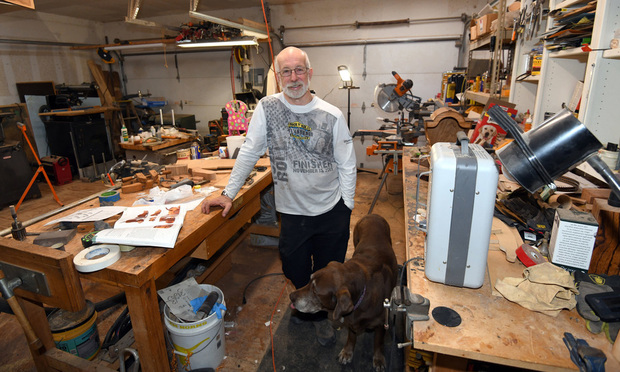Judge's Hobby Takes Him to A Different Kind of Bench
Judge Charles Stephens, 61, said he started making pens—including ballpoints and fountain pens—about 30 years ago as a hobby. “I jokingly tell people it helps my sanity,” he said.
March 28, 2019 at 06:00 AM
6 minute read
 Judge Charles Stephens II, of Comal County Court at Law No. 2, with his dog Annie B. in his wood shop behind his home, in Texas, where he makes custom-wood crafted pens, on Dec. 23, 2018. Stephens made a wood pen for retiring Judge Elsa Alcala, of the Court of Criminal Appeals.
Judge Charles Stephens II, of Comal County Court at Law No. 2, with his dog Annie B. in his wood shop behind his home, in Texas, where he makes custom-wood crafted pens, on Dec. 23, 2018. Stephens made a wood pen for retiring Judge Elsa Alcala, of the Court of Criminal Appeals.
When Judge Elsa Alcala stepped down from the Court of Criminal Appeals at the end of 2018, the court presented her a pen custom-made by another Texas judge as a retirement gift.
Charles A. Stephens II, presiding judge of the Comal County Court at Law No. 2 in New Braunfels, fashioned Alcala's pen partly out of mesquite wood with a cap made of dyed maple. Using a laser-cut pen kit developed by a Nevada man, Stephens made a pen featuring a Texas Lone Star flag motif.
“The pen really is a piece of art,” Alcala said. “It's just clever and original. It's really hard to believe someone handmade it.”
Stephens, 61, said he started making pens—including ballpoints and fountain pens—about 30 years ago as a hobby.
“I jokingly tell people it helps my sanity,” he said.
Stephens has been a judge for the past 15 years. A 1984 graduate of St. Mary's University School of Law, he was a solo practitioner in Canyon Lake before Comal County Commissioners Court appointed him in September 2003 as judge for what was then a new court at law. He took the bench in January 2004 and was elected to a full term in 2005. He has been re-elected three times and also is the innovator behind Comal County's Veterans Treatment Court.
His love of woodworking comes from doing it with his father while growing up. “He pretty much taught me everything I know,” Stephens said. “It's the memories and joy I had with my father that really make it special.”
When he first started his hobby, Stephens said, he would rush home from court to begin working on a pen. Kathleen Stephens, his wife of more than 34 years, thought he was becoming obsessive about making the pens, said Charles Stephens, who doesn't deny that she may have been right. “There was a time when I was obsessive,” he said. “I make the pens when I can now.”
Stephens also has made wooden boxes to hold pens he has custom-made as gifts for some people. “The box is one I designed that will have their name or title on the front and then open from the back to disclose a pen,” he said.
The box that holds Alcala's pen was made of mesquite and, as described by Alcala, is “stunning.”
Stephens said he makes the pens as a hobby and does not sell them, although he does donate some for fundraisers. He noted that one of his sets, a U.S. flag pen and a Texas flag pen with a holder made from a deer antler, sold for $450 at a silent auction. “It is a nice feeling,” he said.
When making a pen, Stephens typically starts with a square piece of wood—the type of wood varies—that he shapes on a lathe. “There's no limit to your imagination,” he said. “That's what I like about it.”
Stephens said he buys a kit that has all the metal parts for the pen. He drills a hole into the piece of wood he's selected so that he can insert the brass tube into it.
Some of the wood Stephens has used to make pens is of historical significance. For example, he has made a number of pens from remnants of the pine wood floor planks removed from Comal County's 1898 courthouse during its restoration in 2013. The county commissioners let him take some scraps of the wood flooring that they were unable to use in the restoration.
“They were long leaf pine tongue and groove floor planks about three inches wide,” he said. “I had to make sure there were no nails in them and trim them to size.”
Because pine is a soft wood, he had to be careful when turning it on the lathe. Stephens said that he sometimes used a super glue to hold the wood together while turning it on the lathe.
“It takes very little wood to make a pen,” he said. “I probably still have enough for 10 or so pens.”
Stephens said he also has made pens from Bethlehem olive wood and from the wood in Jack Daniels whiskey barrels. In addition, he has made pens from bull horns and deer antlers and from Corian, a type of countertop material. Some of his more unusual pens are made from dried corn cobs that he has dyed using a pink acrylic.
Stephens also has used wood ashes from his barbecue pit with an acrylic/resin substance to make pens. “What I did was simply add ashes to the clear acrylic,” he explained. “I was playing, and it worked pretty well.”
As part of the process, the judge pours the acrylic substance into a mold that is about six inches long, one inch wide and one inch long, and lets it harden. Once the blank is prepared, he places it in a pressure pot for about two hours to cure it.
Wood ashes are plentiful around Stephens' home. He is a member of “Final Justice,” a barbecue competition team that includes former and current courthouse employees who have won trophies for their barbecued meats.
“Out of my house I have a barbecue area that I've created,” Stephens said. “I've cooked for up to 250 people out there. I do all the sauces.”
Stephens said his daughter named his home barbecue area “BBQ Grove, Texas.”
This content has been archived. It is available through our partners, LexisNexis® and Bloomberg Law.
To view this content, please continue to their sites.
Not a Lexis Subscriber?
Subscribe Now
Not a Bloomberg Law Subscriber?
Subscribe Now
NOT FOR REPRINT
© 2025 ALM Global, LLC, All Rights Reserved. Request academic re-use from www.copyright.com. All other uses, submit a request to [email protected]. For more information visit Asset & Logo Licensing.
You Might Like
View All
No Two Wildfires Alike: Lawyers Take Different Legal Strategies in California
5 minute read
Energy Lawyers Field Client Questions as Trump Issues Executive Orders on Industry Funding, Oversight
6 minute read

Holland & Knight Hires Former Davis Wright Tremaine Managing Partner in Seattle
3 minute readTrending Stories
- 1New York-Based Skadden Team Joins White & Case Group in Mexico City for Citigroup Demerger
- 2No Two Wildfires Alike: Lawyers Take Different Legal Strategies in California
- 3Poop-Themed Dog Toy OK as Parody, but Still Tarnished Jack Daniel’s Brand, Court Says
- 4Meet the New President of NY's Association of Trial Court Jurists
- 5Lawyers' Phones Are Ringing: What Should Employers Do If ICE Raids Their Business?
Who Got The Work
J. Brugh Lower of Gibbons has entered an appearance for industrial equipment supplier Devco Corporation in a pending trademark infringement lawsuit. The suit, accusing the defendant of selling knock-off Graco products, was filed Dec. 18 in New Jersey District Court by Rivkin Radler on behalf of Graco Inc. and Graco Minnesota. The case, assigned to U.S. District Judge Zahid N. Quraishi, is 3:24-cv-11294, Graco Inc. et al v. Devco Corporation.
Who Got The Work
Rebecca Maller-Stein and Kent A. Yalowitz of Arnold & Porter Kaye Scholer have entered their appearances for Hanaco Venture Capital and its executives, Lior Prosor and David Frankel, in a pending securities lawsuit. The action, filed on Dec. 24 in New York Southern District Court by Zell, Aron & Co. on behalf of Goldeneye Advisors, accuses the defendants of negligently and fraudulently managing the plaintiff's $1 million investment. The case, assigned to U.S. District Judge Vernon S. Broderick, is 1:24-cv-09918, Goldeneye Advisors, LLC v. Hanaco Venture Capital, Ltd. et al.
Who Got The Work
Attorneys from A&O Shearman has stepped in as defense counsel for Toronto-Dominion Bank and other defendants in a pending securities class action. The suit, filed Dec. 11 in New York Southern District Court by Bleichmar Fonti & Auld, accuses the defendants of concealing the bank's 'pervasive' deficiencies in regards to its compliance with the Bank Secrecy Act and the quality of its anti-money laundering controls. The case, assigned to U.S. District Judge Arun Subramanian, is 1:24-cv-09445, Gonzalez v. The Toronto-Dominion Bank et al.
Who Got The Work
Crown Castle International, a Pennsylvania company providing shared communications infrastructure, has turned to Luke D. Wolf of Gordon Rees Scully Mansukhani to fend off a pending breach-of-contract lawsuit. The court action, filed Nov. 25 in Michigan Eastern District Court by Hooper Hathaway PC on behalf of The Town Residences LLC, accuses Crown Castle of failing to transfer approximately $30,000 in utility payments from T-Mobile in breach of a roof-top lease and assignment agreement. The case, assigned to U.S. District Judge Susan K. Declercq, is 2:24-cv-13131, The Town Residences LLC v. T-Mobile US, Inc. et al.
Who Got The Work
Wilfred P. Coronato and Daniel M. Schwartz of McCarter & English have stepped in as defense counsel to Electrolux Home Products Inc. in a pending product liability lawsuit. The court action, filed Nov. 26 in New York Eastern District Court by Poulos Lopiccolo PC and Nagel Rice LLP on behalf of David Stern, alleges that the defendant's refrigerators’ drawers and shelving repeatedly break and fall apart within months after purchase. The case, assigned to U.S. District Judge Joan M. Azrack, is 2:24-cv-08204, Stern v. Electrolux Home Products, Inc.
Featured Firms
Law Offices of Gary Martin Hays & Associates, P.C.
(470) 294-1674
Law Offices of Mark E. Salomone
(857) 444-6468
Smith & Hassler
(713) 739-1250






